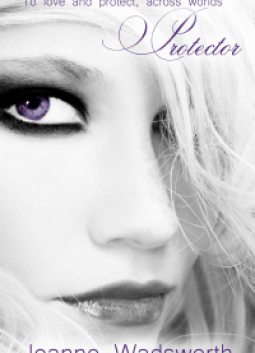by Joanne Wadsworth | Aug 13, 2012 | Author Blog
 PROTECTOR–(To be published 7th January 2013 with Lyrical Press, Inc.)
PROTECTOR–(To be published 7th January 2013 with Lyrical Press, Inc.)
Young Adult, Fantasy, Paranormal, Romance
To love and protect…across worlds.
Eighteen-year-old Faith Stryker is prepared to leap out into the unknown world beyond her home shores of New Zealand to experience life. Only she never expected to encounter Magio, a planet with two warring countries, where its people reach adulthood at eighteen by coming into their strength and prophetic abilities. Only after Faith discovers she’s a halfling–thanks to her warrior father she’s never met–does her own skill of forethought develop.
Peacio’s Prince Davio Loveria is sent to the young Faith Stryker by his grandfather, but not all goes as planned. Davio discovers Faith isn’t just a halfling, she’s also his soul-bound mate–an intense relationship he cannot, nor will not, give up.
With two wars now waging…one of land and the other of the heart…can the young lovers find their place in the world?
I’m super excited to bring this cover art to you all. For me, this is a dream come true. Thanks everyone for joining me on my journey to publication.
by Joanne Wadsworth | Aug 12, 2012 | Author Blog
 As writers we never intentionally set out to frustrate the reader, but mistakes happen and blunders are made, ones which we usually wish someone had enlightened us on at some point in time. So here I go, aiming to shine a light on those common slip-ups which can make the reader say, “Ah, what?”
As writers we never intentionally set out to frustrate the reader, but mistakes happen and blunders are made, ones which we usually wish someone had enlightened us on at some point in time. So here I go, aiming to shine a light on those common slip-ups which can make the reader say, “Ah, what?”
Naming Your Non-Speaking Characters
As you’re no doubt aware, when we name the major players in our story, this is our reader’s clue that this person is someone of importance, and they’ll note those names and pay attention. So that being the case, make sure you don’t make the mistake of naming your non-speaking/non-pivotal characters. Your reader isn’t going to care about the name of the next door neighbor, or the waitress who serves her coffee, the delivery boy, or even the name of the cute dog who lives next door and wags his tail.
You want to make certain you don’t frustrate your reader, because those clues they look for can get lost within the maze of names if you do. So keep in mind, that unless the person serves an essential role, they should remain a nameless prop within your story.
Too Many Bodily Processes
Here we go— Her heart raced. She struggled to catch her breath. Her heart beat in her chest. She sobbed in choking gulps.
Yeah, sometimes I’ve read too many of these short “shows” within a half page of writing, and I’ve actually wondered if the heroine is about to have a heart attack (if you get my drift.) This can be frustrating for the reader, so make sure you go easy on these, and ensure you show in all the ways we have open to us as writers. Always remember to include strong dialogue and narration to drive your scene, giving a good blend of all the elements.
Characters Calling Each Other By Name — When Is It Too Much?
Oh boy, this is a something that frustrates me when I’m reading a book. And to explain it fully, let me set the scene to give you an accurate description of what I mean.
Here Jack is sitting on a chair in the dining room, and Jane comes in after a long day at work. It’s just the two of them having a conversation.
“Did you have a bad day, Jane?” Jack sat forward, watching her intently.
She tilted her head, and blew out a breath. “Jack, what was your first clue?”
“Oh, I don’t know, Jane. Perhaps it was the way you stomped into the room.” He stroked his jaw. “Why don’t you tell me about it?”
She clenched her fists and glared. “I hate my job, Jack. I can’t stand being the one everyone unloads their work on.”
Okay, I went overboard on the name use, but what I’m trying to point out is that any reader will get that Jack and Jane are having a conversation, and as writers, we need to eliminate any overuse of our characters’ names. So often I’ll be reading a passage where it’s just the hero and heroine present and they’re saying each other’s names in general conversation as I’ve recorded above. But why? I mean how often do you say someone’s name once you’re already speaking to them?
And to make certain we’re all on the same page, here’s the example rewritten without the overuse of names—
“Did you have a bad day, Jane?” Jack sat forward, watching her intently.
She tilted her head, and blew out a breath. “What was your first clue?”
“Oh, I don’t know. Perhaps it was the way you stomped into the room.” He stroked his jaw. “Why don’t you tell me about it?”
She clenched her fists and glared. “I hate my job. I can’t stand being the one everyone unloads their work on.”
As you see, the dialogue was strong enough to dispense with the names straight after the opening line. It was more than obvious exactly who was speaking. So, once your scene is set, and your reader knows who is who, then don’t bring their names back in until the scene changes, or it’s unclear who’s speaking, or you’re just plain driven to drop that name back in. (And you’ll know what I mean when that happens, but until then, judge your own writing and don’t allow yourself to go overboard.)
Question: Of the three common mistakes I’ve mentioned, which frustrates you the most when you’re reading? And if there’s any other that really exasperates, make sure you tell me and I’ll mention them in a future post. Because that’s what I’m all about–ensuring writers support writers by keeping us all informed.
That’s all folks, and I hope my blog post this week has been immensely helpful. If you haven’t joined me for your weekly dose of bite-sized writing tidbits and you’d like to, then simply check out the right-hand side panel, and enter your email address to “follow the blog.” If you want, also click “like” on my FB author page to the right. I love all the support.
* * * *

PROTECTOR–BUY THE BOOK: Amazon Kindle / B&N Nook / iTunes / Lyrical Press / Kobo.

by Joanne Wadsworth | Aug 5, 2012 | Author Blog
 It’s so important to always go over every scene we write, and then to rewrite until we’re absolutely certain we have it nailed. The following scene is a good example of one, where although not wrong, there are still things to improve. Let me set the scene, and then we’ll rewrite, and see if you prefer the changes.
It’s so important to always go over every scene we write, and then to rewrite until we’re absolutely certain we have it nailed. The following scene is a good example of one, where although not wrong, there are still things to improve. Let me set the scene, and then we’ll rewrite, and see if you prefer the changes.
Matilda is in the countryside, having gone for a walk with her friend, Cole, at his place. The two stop at a low stream and she wishes to cross it.
- Several huge oaks made up a natural umbrella over a small inlet of the stream. Sunlight glistened like dancing jewels off the clear blue water. As she drank in the soothing landscape, Matilda realized the trees stood on the other side of the stream, which looked less than lazy. She peered up and down but didn’t see a bridge. “Is the stream too deep to walk across?” she asked Cole.
In this example there is some inaccuracy in how the scene is drawn through the center portion, so let’s rewrite, actually placing ourselves there by the stream to do so.
- Several huge oaks made up a natural umbrella over a small inlet of the stream. Sunlight sprinkled through the swaying green foliage and lit the surface of the rippling blue water. The dancing jewel tones glistened and Matilda drank in the soothing landscape. She peered to the left and to the right, searching for a bridge to cross. Releasing a sigh, she glanced at Cole. “Is the stream too deep to walk across?”
I hope you get my meaning. In the rewrite, slight changes have been made to direct the scene’s order more accurately. I now have Matilda noticing the huge oaks over the stream as her gaze would have been directed upward, then she sees the sunlight coming through the foliage and highlighting the surface of the rippling water as she looks down. She enjoys the view, and then looks for a bridge to cross.
Such small tweaks, yet every sentence we write must be polished to perfection. If you find you’ve written something that’s bugging you, then go back and follow each stage of what would have happened to your character in real time, then ensure you capture each of the essences in the right order.
Do you think that’s all this paragraph needed and now reads better? Leave a comment if you wish—I always love them.
Thanks for joining me, and I hope you tune in next week for some more bite-sized tidbits. Simply check out the right-hand side panel, and enter your email address to “follow the blog.” If you want, also click “like” on my FB author page to the right. I’d love you to join me.
* * * *

PROTECTOR–BUY THE BOOK: Amazon Kindle / B&N Nook / iTunes / Lyrical Press / Kobo.

by Joanne Wadsworth | Jul 30, 2012 | Author Blog
 As writers we can become so caught up in telling our story, that we inadvertently slip into bad habits which can offend the reader’s intelligence. I’m talking about simple issues which we can become more mindful of. So here’s a list to aid you.
As writers we can become so caught up in telling our story, that we inadvertently slip into bad habits which can offend the reader’s intelligence. I’m talking about simple issues which we can become more mindful of. So here’s a list to aid you.
Adverb Overuse
“He grinned happily.” Here, the obvious is stated with the verb “grinned,” and the adverb “happily” isn’t needed for your reader to understand the context of what you’ve written. One should just say, “He grinned.”
“She screamed loudly.” Um, as opposed to screaming softly? I know I got the meaning from “she screamed.” What about you?
“She whispered quietly.” Because one can whisper loudly?
Yeah, I imagine my meaning is becoming clear on adverb overuse. As writers, we simply need to take care when using them. We need to consider what’s acceptable and what isn’t. Which brings me to the times when you will need to take your verb and add an essence which is more than what’s being implied. In those cases you will need to extend. Eg– “She whispered conspiratorially.” “She whispered hastily.” There’s a reason beyond, and here you’re taking the whisper and specifically quantifying it, and that’s all good.
Ellipses (…) Yes, Those Three Dots
Even though I understand why writers use ellipses, that they wish to make the scene more dramatic with a pause, I…still…cringe…because…I…want…to…read…faster. See, annoying isn’t it?
Although my moment of humor aside, I can’t deny ellipses do have their place so don’t get me wrong, but what I’m asking is that you take care with them, ensuring you only use them where absolutely necessary. Think sparingly–that’s best.
Unnecessary Point Proving
Here are some examples–
He stormed from the room in anger.
He scowled with condemnation.
She cried tears of frustration.
In the first example the character is “storming from the room in anger.” Say this has arisen from a heated argument between your characters, then your reader will understand he’s angry because you’ve portrayed it correctly. Readers don’t need things spelled out to them. You can just say, “He stormed from the room.” The second and third examples are the same. If the scene shows your hero’s condemnation and your heroine’s frustration arising from the same heated argument, then don’t go doubling up, by showing and telling your readers. They’ll get it. Keeping things simple never hurts, and adding qualifiers to prove our point can at times have the opposite effect to what we’re after.
Now in saying this, there will also be times when it’s perfectly acceptable to use qualifiers, but never forget, it’s strong dialogue and narrative which should carry a scene. Judge it for yourself, but if you’ve drawn a scene well, then your reader will be able to ascertain all that is needed without any overuse of words which state the obvious. Again, think sparingly–that’s all.
Well, I hope my blog post this week has been helpful, and if you haven’t joined me for your weekly dose of bite-sized writing tidbits and you’d like to, then simply check out the right-hand side panel, and enter your email address to “follow the blog.” If you want, also click “like” on my FB author page to the right. I love all the support.
* * * *

PROTECTOR–BUY THE BOOK: Amazon Kindle / B&N Nook / iTunes / Lyrical Press / Kobo.

by Joanne Wadsworth | Jul 23, 2012 | Author Blog
 As writers we all want to hear about the changes in publishing, and the good news is, that right now is the most amazing time to be a writer. That’s right–clappity, clappity.
As writers we all want to hear about the changes in publishing, and the good news is, that right now is the most amazing time to be a writer. That’s right–clappity, clappity.
There’s a revolution underway and opportunities are opening up for all of us. Along with traditional publishers, there are e-readers, e-books, indies, and POD publishing. The game is expanding, but most of all the digital age is upon us.
And this is where we as writers come in. We must evolve with the times. Sure our books are our babies, and the characters and stories feel like a part of us, but once we move on publishing our first novel, (and in any of the ways possible) we soon discover that writing is a business.
As authors we have to be social media savvy, and promote our own work, no matter which avenue of publishing we take. We have to be active in having a presence which aids in building our sales.
- So if you don’t have a website–get one. You’ll find some great free website providers, one’s whose home page doubles as a blog roll. This all-in-one package is a tidy option.
- Which brings me to having a blog. As a writer you should try it. You’ll be surprised what you can yak about, and it’s a great way of connecting with your followers.
- Facebook author page–a must, and months in advance of publishing. Have fun with it, leaving comments which can create conversation with those who’ve liked your page. Think personal–connect with people on the same level that you’d want to be connected with.
- Twitter account–heck yes. Absolutely. Essential–I’m not kidding you. Say you hate using twitter, but hey, you’ll get over it. LOL. I’ve met the best people on twitter, and formed friendships with like-minded people. I was petrified the first month I sent tweets out. I was so worried about saying the wrong thing, but before you know it, you’ll be speaking your mind, and having conversations with people and building your network platform. Whatever you do, do not underestimate the power of twitter. What I’ve discovered is it sets the stage for writers–that’s if you use it to its full potential.
- Goodreads–hey, now this is a valuable tool to reach readers and writers. Join groups within the genre you write, and search out your favorite publishers’ pages, ensuring you interact with their authors. Get a feel for the bigger picture, because arming yourself with information is essential.
- Building a rapport with Book Bloggers–of course. Support them on their blog in the weeks before you release your book, leaving constructive and valued comments. They’ll notice your repeated visits, and that’s setting your stage. You truly don’t want to ask a book blogger for a review, without being somewhere on their radar first. They’re busy people.
- Pinterest–okay this one I’ll say if you want to, because even I’m fumbling my way around it.
And obviously I could go on and on–but these sites are the most obvious for you to begin with.
And for those aspiring writers reading this post who are only just beginning, I imagine you might now be scrunching up your face. There’s so much to do, but just tackle one job at a time. Just don’t pass over these terrific opportunities. Publishing is changing, and as writers, we need to get our books in front of readers, and the social media sites I’ve listed above provide that opportunity on a global scale.
You have to remember that with the explosion of technology, this has become the Golden Age for publishing. It’s vital you brand your name, and then get your first book published by whatever means you can. Don’t ever look back, because as writers, each piece of subsequent work we write, gets better and better. Just dive in–your skin will thicken over time. 🙂
I hope you’re feeling uplifted, and not too overwhelmed. Leave a comment or ask a question if you wish–I’m happy to elaborate. And if you’ve enjoyed this week’s post, then tune in next week for some more bite-sized tidbits. Simply check out the right-hand side panel, and enter your email address to “follow the blog.” If you want, also click “like” on my FB author page to the right. I’d love you to join me. (See–that’s me being savvy.) 🙂
by Joanne Wadsworth | Jul 15, 2012 | Author Blog
 There are times as writers when we can’t help but use a metaphor to describe an image, but if we can, we should always go back over the scene and see if there’s a better way to “show” our reader, without their use. Let me draw the following scene for you, where a metaphor is used in the first line, and then we’re going to zip-zap it away.
There are times as writers when we can’t help but use a metaphor to describe an image, but if we can, we should always go back over the scene and see if there’s a better way to “show” our reader, without their use. Let me draw the following scene for you, where a metaphor is used in the first line, and then we’re going to zip-zap it away.
Ana, a young woman, is visiting her friend in the countryside. Ana has saddled up a horse from the stables, and is ready for a ride.
- Riding a horse was like riding a bike, Ana thought, lifting her face to the sun. Once in the saddle, she felt like it had been only a day instead of years since the last time. She knew she’d pay the price the next day, but she enjoyed the feeling of freedom she always felt when riding. The chestnut mare, Mandy, was gentle but spunky.
In this above scene, the paragraph’s meaning is quite clear because of the metaphor. Riding a horse is like riding a bike. And for Ana, it’s also been years since she felt that freedom. But as writers we need to extend these kinds of scenes, going past the obvious and bringing our reader along on the journey. Ana may be going for a ride, but there’s so much more we can say. I’m not sure about you, but there’s a definite picture forming in my mind of the scene, but the example above isn’t quite cementing it. See what you think of the rewrite in the following example, and if the picture now becomes more clear.
- Lifting her face to the sun, Ana breathed in the fresh country air as it blew across the rolling green fields. It had been years since she’d last been atop a horse, but no matter the length of time, the moment she’d set her booted foot in the silver stirrup and swung up, those years had melted away. Even the smooth leather reins in her hands, and the gentle tug as the chestnut mare whinnied for release, made her itch to move, to give into the freedom of the ride.
In the rewrite, the metaphor is gone, and the picture I visualized has been brought to life. I hope as you read the second example, that you too felt the metaphor wasn’t needed. So if you can, take the time to be inventive and to visualize what you want to write, and then deliver it. Search for those metaphors, and cut them out. I’m sure your readers will thank you for it.
Now, if you’ve enjoyed this week’s post, then tune in next week for some more bite-sized tidbits. Simply check out the right-hand side panel, and enter your email address to “follow the blog.” If you want, also click “like” on my FB author page to the right. I’d love you to join me.
 PROTECTOR–(To be published 7th January 2013 with Lyrical Press, Inc.)
PROTECTOR–(To be published 7th January 2013 with Lyrical Press, Inc.)



